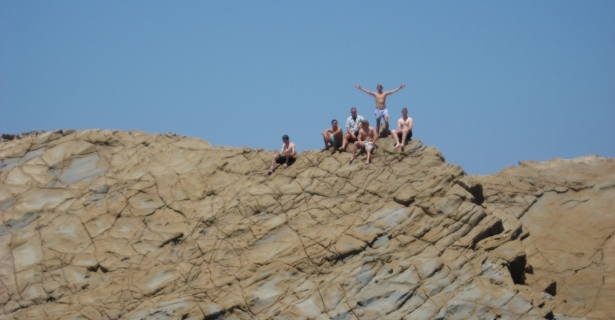Written by Roland Gillah, member of ALLIES and class of 2016
This post is part of a series of student reflections from ALLIES Joint Research Projects around the world
This weekend we stopped at Sulva beach, our last beach on a tour of the Gallipoli landing beaches. We walked round the cove, over small boulders, shale, and then onto a pebble beach which had an incredible collection of skipping stones. Six of the guys, including Commander Gibb, made the slippery journey across the water to a large rock formation jutting out from the water. The girls, Patrick, and I, only made it about halfway into the water. They then swam back as we hiked around the beach carrying the stuff they had left behind. It was a very beautiful, sunny day and the water was very refreshing; hard to believe such carnage had taken place almost a century ago. 98 years since the failed expedition, another group of Allies took Gallipoli.
On Saturday, we began our tours of the Gallipoli landings by visiting the numerous graves of fallen soldiers. Even though many of the graveyards had lines of small headstones, in each there was one large plaque that said, “In this graveyard, 3,000 unknown dead.” Three thousand dead. That is an insane number; it is not even the total deaths of one side or even one country in a battle, but only the nameless, faceless enormity of bodies the could not find to bury. Standing there and thinking of all those who died, you can’t help but wonder what on earth was the point? What cause could be so necessary that merited the sacrifice of so many? What about the war? More poignant than these questions, which tend to come up at World War I graveyards, was that in traveling with military folks, we were viewing a memorial with those who could someday be in a similar position as those soldiers. I finally worked up the nerve to ask one or two of them what the sight of such a vivid symbol of the loss of soldiers meant to them as future men and women of the armed forces. Their responses were fascinating and quite personal.
While standing in a circle under a tree in one of the graveyards, Commander Gibb highlighted the graveyards as a visual reminder of the cost of military decisions. Both the future leaders of the military and we, the civilians with the power to perhaps influence or make the decisions that lead to such engagements, have a responsibility in planning and executing conflicts such as this. When we decide on a course of action that involves the military, he said, we will have not faceless names and unknown bodies but the images of the cadets in front of us, who would be the ones to carry out whatever action was decided. But every action has a cost, and it is critical to know not only at what point you would make personal sacrifices but, and he addressed the military cadets, at what point you would ask your subordinates to do the same.
Later, stopping by the Ottoman graves, our guide emphasized how multicultural the empire was. The memorial was designed like a church but with the spire and crescent of a mosque. He leaned down and pointed at a particular headstone.
The word OĞLU meant “son of.” KUDÜS was the Ottoman word for Jerusalem. MUSA meant Moses. The fallen soldier was Jewish. It is easy to assume all the Ottoman forces were Muslim Turks, but in fact, they were pulled from all over the Middle East.
As far as our research goes, after our latest meetings with Professor Soli Özel, a key word and a razor-wit, and a U.S. government official, and now some professors at Kadir Has University, we are at the point where we are broadening our research questions to really get into the crux of our topics. A number of us went in with certain assumptions about Turkish aspirations or the state of Turkish democracy that with the guidance of our contacts we have had to adjust. Also, our questions are becoming informed by the debates we’ve had amongst ourselves on the hijab, women in the military, and other issues related to our topics. It is quite dynamic to see our research evolving right in front of our eyes.
This trip has given us the chance to interact more with each other than our research, and amongst the philosophical debates and ALLIES planning, we’ve had plenty of humor too, frequently embodied by the exchanges between a certain Naval cadet and Commander Gibb.
Gibb: “I’m going to go upload some pictures onto Facebook”
Drew: “But who’s going to see them?”
G: “I wish I could be as popular and well-dressed as you, Drew. I just wish I had as many Facebook friends!”
D: “I saw you took that fanny pack off and put it on your shoulder.”
It’s good to know we’re only a week in.


Add new comment